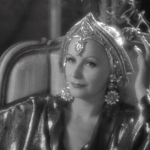 |
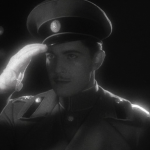 |
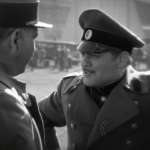 |
| Mata Hari Greta Garbo |
Alexis Rosanoff Ramon Novarro |
General Shubin Lionel Barrymore |
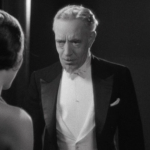 |
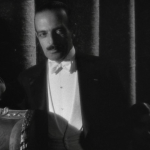 |
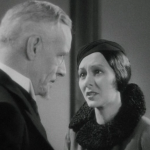 |
| Andriani Lewis Stone |
DuBois C. Henry Gordon |
Carlotta Karen Morley |
| Released by MGM | Directed By George Fitzmaurice |
||
Proof That It’s Pre-Code
- The titular Mata Hari is an exotic dancer who doubles as a spy in Paris during the first World War. She gains a great deal of protection via sex– mainly, the amount of it she seems to have with everyone with an ounce of power.
- Actually, a lot of the most scandalous stuff was cut out of most release prints upon reissue in the late 1930s, including longer seduction scenes, skimpier outfits, and the possibility of seeing Garbo in even less than ‘skimpy’. There’s a note about it down in the Trivia section.
Mata Hari: Destructive, But Seductive
“Just tell him that no matter what he hears… and he will hear things… that my love for him was honest. That’s all. Except that he must be happy, and must laugh, and… love. And then, someday, when he’s an old man, and his grandchildren ask him about Mata Hari, he must tell them a brave lie and tell them that she was a wonderful woman. And that’ll be my heaven.”
Story time: back in the day (let’s go with 2005, which seems a lot longer ago than it was, I suppose) I worked at a videostore. My Christmas bonus for the year was a $25 gift card to Best Buy, so I took my then-girlfriend and, like all super sexy 22-year-olds, decided to use the card as a down payment on the recently released Greta Garbo Signature Collection.
Sure, I’d never seen a Garbo movie, which was part of the appeal. Who was this great actress, and what treasures would soon be in my hands?
Well, bad news. My girlfriend and I picked poorly and started with Camille, one of those movies that, to this day, I assume most of the praise for is completely sarcastic. We stumbled through a few more of her features but found them all very dry and dramatic. Garbo herself has a wry sense of humor, sure, but each of her movies we saw followed one of the strands of the “women’s pictures” formula: beautiful woman meets the perfect man, sexual fireworks, and then noble, noble death.
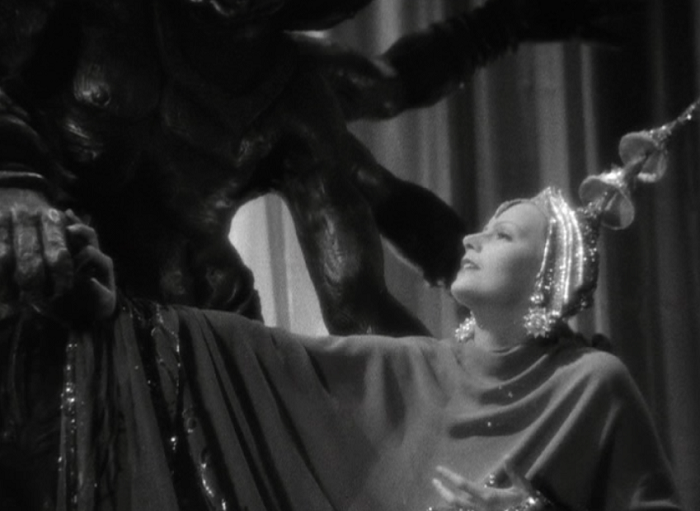
“Hey, baby, would you give me a hand?”
Almost a decade later and I’m having flashbacks. Mind you, I don’t blame Garbo for the formula: it worked. It was an immensely popular formula, something akin to our modern day “bland white guy goes on a hero’s journey usually in a spandex outfit or with laser swords or possibly both” sort of movie.
Mata Hari is a fictionalized version of real life spy Hari’s downfall. It’s Paris during the war, where the chief of spies DuBois (Gordon) suspects Hari’s connections and motivations are something less than purely French. Hari does her espionage between the bedsheets with the most powerful men in the country, which, ironically, makes her hard to pin down.
Her biggest source of information is the Russian General Shubin (Barrymore), in Paris to consult on the war and desperately, hopelessly in love with Hari. She laughs over his obsession; she’s too much of a free spirit to take his protestations of of love very seriously. This attitude worries Andriani (Stone), her German contact, who sees her capricious nature as a disadvantage. Mata Hari believes in pleasure– her pleasure– above all other matters.
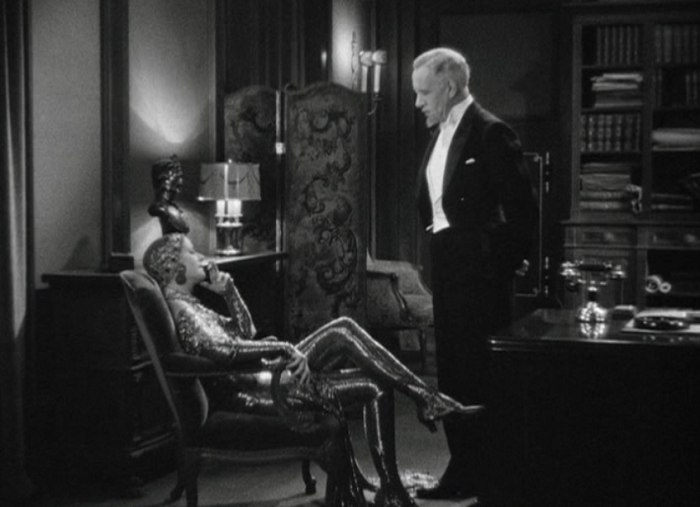
She also believes in her sparkly outfits.
That is until she meets Russian pilot Alexis Rosinoff (Novarro), a spry little go-getter who just completed a flight from Russia to Paris over the treacherous territory of the German Empire. Alexis becomes obsessed with Mata, and she obliges his puppy dog sexual desire just for a kick. When it turns out that he’s holding onto a vital strategic message in preparation for flying it back to Russia, she seduces him again.
If the first seduction was merely acquiescing to a fond, handsome admirer, the second seduction is something far more insidious on Mata’s part. She demands flattery and loyalty. When he turns off the lights to prepare for their lovemaking, she demands he blow out the candle he keeps eternally lit in honor of both his own mother and the Virgin Mary. He protests, but Mata coyly explains that it’s either God or her. He apologizes to the Virgin and blows out the candle; I think Mary of all people probably understood the desire, though maybe not the action.
That’s the high point of Hari’s powers and selfishness. Their lovemaking that night gives her pause, and the audience is left to infer what happened behind the door that makes her reconsider the previous night’s manipulations. She apologizes to Mary and relights the candle, beginning her reformation from sinner to saint. From this point on, even Hari’s hats become less ostentatious as she becomes pious, a new found apostle to romance.
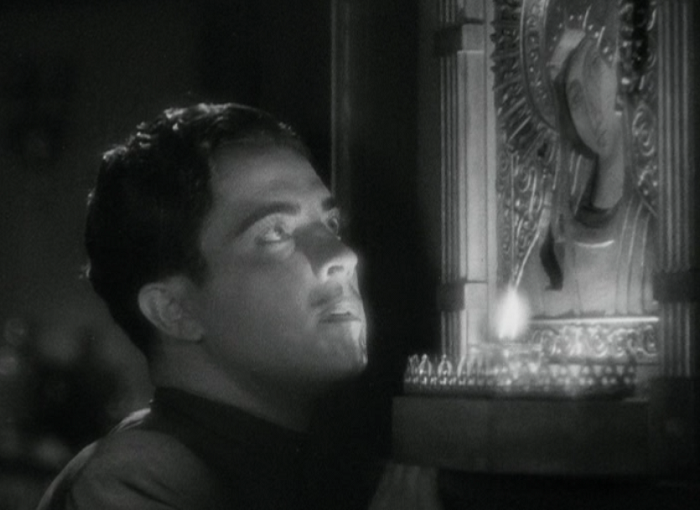
Blow the candle! Blow the candle!
DuBois, meanwhile, is closing in on Shubin. Playing off his jealousy, Shubin becomes obsessed with Mata Hari’s nocturnal activities with Alexis and threatens to turn them both in to the French police. Mata, even though her connections could certainly save her own life, shoots Shubin and damns herself as a spy when he threatens Alexis. She’s set to meet a firing squad. Alexis, meanwhile, is blinded in a plane crash. Hari chooses not to tell him about her fate, instead indicating she’s going in for a minor medical procedure. After a romantic goodbye, she is marched off to the gallows.
To the movie’s credit, Greta Garbo is great. She’s certainly better at home here as an exotic spy than she was as a poor sailor’s daughter in Anna Christie and more accessible than her role as a reclusive ballerina in Grand Hotel. She is redolent in her sultry charms, ability to project carefree with a wry smile, and Mata’s transformation into a martyr by the film’s end is accessible and sympathetic. That speech I quoted at the top of the review is heartbreaking, and Garbo nails the right sense of resignation and hope in delivering it.
Ramon Novarro, however, undermines a lot of the film’s dramatic weight. The youthful looking Novarro, once a silent film matinee idol, has an unfortunate mustache that looks like one a 16-year-old would grow in hopes of looking more mature than they are. I know, this could be argued to be intentional, but it turns the lovemaking scenes from the portrayed erotic awakenings for Mata to some mustached kid’s American Pie moment. His Spanish accent, too, sounds ridiculous coming from a Russian pilot. While I really liked the guy in The Cat and the Fiddle, his character of Alexis is devoid of humor and much of any depth, a monochromatic slave to love.
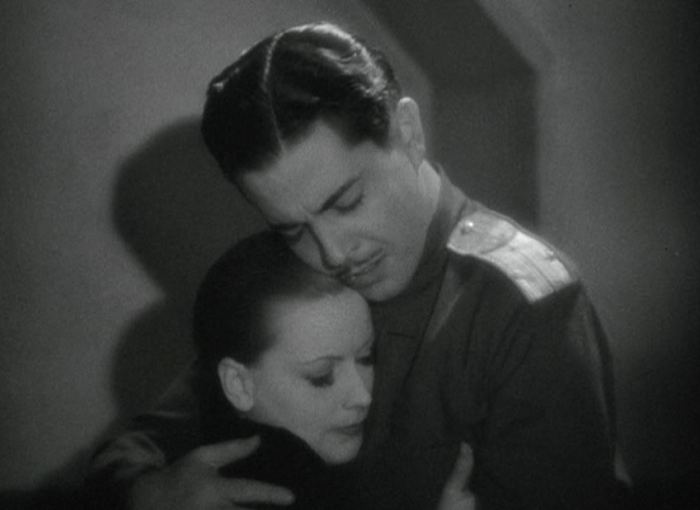
He’s also apparently wearing stilts here.
The rest of the cast is great. Lionel Barrymore, for whom the word ‘irascible’ seems eternally assigned, does his best to steal the picture from everyone involved. Karen Morley’s small role as the spy Carlotta is gut wrenching. Lewis Stone, so often remembered for his paternal role in the Andy Hardy series, is a stone cold spymaster. His Andriani, who notably escapes the movie without punishment, is ruthless and in his first scene hands a gun to a spy who had laughed off the idea of the tank. The stiff stare that accompanies the hand off is chilling.
“A spy in love is a useless tool.”
The film’s biggest star, even over the great Garbo, is Adrian, the costume designer. Mata Hari’s slinky outfits, from skimpy negliges to sequin-adorned gowns, show off her body with a hedonistic vigor. Her hats, which regrettably cover Garbo’s beautiful hair, are ornate and… well, ludicrous. Check out her cap with its dangling circular charms or the multi-tiered tower she dons for her early striptease. Her headgear is an obfuscation, the only disguise for perhaps the most famous (and obvious) spy in a country engulfed in war.
Since this entry is part of The Snoopathon, I think it’s worth looking over this film’s take on spy play. Even with the film kicking off with Mata Hari rubbing her body all over while trying her best to arouse a statue of Shiva, there’s not much in this movie that makes it your usual action movie fodder. If I had to pick a closer relative, something like British Agent (1935) or Army of Shadows (1969) comes to mind; for both sides, it’s a shell game. Spies live and die, are exploited and reassigned, and every iota of progress is precarious. But this is a ground level story, and the spies never see what they’ve lost or what they’ve gained.
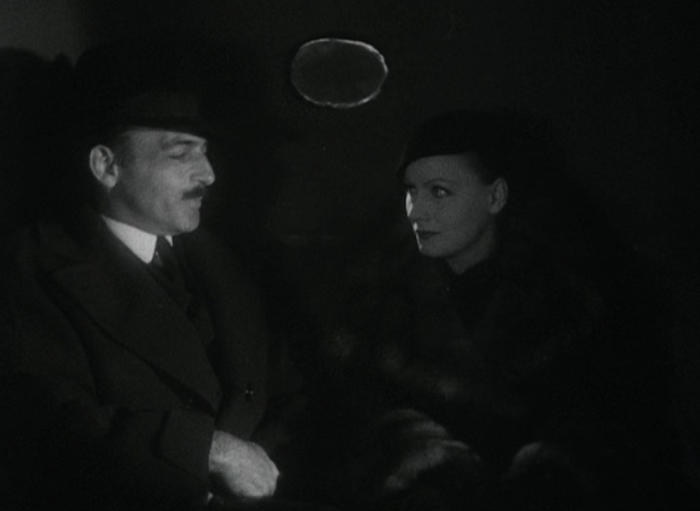
Spy and spy, side by side.
One of the film’s best tricks in this regard is the character of Jacques (Michael Visaroff). We’re introduced to him like a typical villainous henchman in a Bond movie; German spymaster Andriani yells “Jacques!”, and we see two feet appear. Only there’s a unique characteristic– notably, one of the feet is a club foot. Sure, it’s not a hat with a razor blade or teeth with… uh, razor blades, but the physical deformity is a time honored indicator for ‘murderous madman’, as insensitive as it may be. We don’t see Jacques face as he tracks down and then murders Carlotta off screen, but we later see him in a medium shot, helping to carry her body away.
(Brief side note: the script delays Carlotta’s scream of realization at Jacques arrival by a few minutes by cutting away to Mata Hari. It’s an excellent way to build tension, and a rather unique way to keep the audience engaged for what is surely a foregone conclusion.)
Not showing Jacques face at first is a smart conceit. It makes him a question mark, and the threat is Carlotta may not know his face either. (Would you have the chief enforcer of your spy ring be widely known or would you keep him in the shadows?) But then we do see his face, as we also see him limping and Carlotta’s freshly killed body. Here, Mata Hari is seeing the price of betrayal, and the audience is seeing Jacques, not as the invisible, unstoppable punishment, but the grunt doing his job. We see him as a short pudgy man with just a few tufts of hair and a pronounced limp. It underscores the mystery and danger of being a spy, but also the mundane, business side.
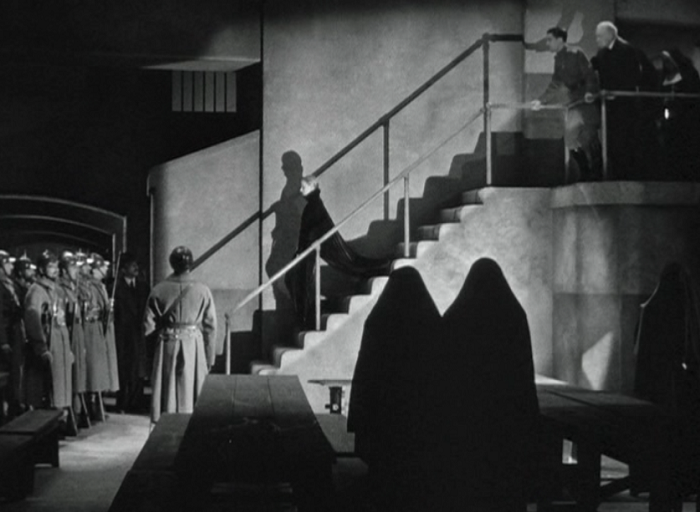
It looks good, but it’s still a weird way to light a room.
Hari’s glamor leads her to see herself above the spy games, which brings on its fair share of trouble. As Angela noted over at The Hollywood Revue, Hari was, “the least inconspicuous spy of all time.” Her inability to understand the reality of her situation leads to her capricious treatment of the obviously dangerous Shubin and wholly unable to anticipate how a real romance would affect her web of protection.
That also leads me to another one of my sore points with the film. During Hari’s transformation from spirited stripper to doomed romantic– despite her martyrdom in the last reel– the movie never convincingly makes her come to terms for what she’s done. Her spying has certainly cost hundreds of thousands their lives. The film’s only attempts to address this is a brief moment where she wanders through a veteran’s hospital and finds herself talking to severely injured soldiers. Despite what she’s seeing, it never really feels like she makes the connection between her spying and the harm that she caused. In itself, that makes this very pre-Code; she doesn’t learn that betrayal and murder is a bad thing, but rather a World War is inconvenient to an illicit love affair. But it also serves to make that love affair seem more flighty and false. After the story ends, I’m still not so sure what the devotion that Alexis offers is so much more appealing than that of all her other suitors.
The film is beautiful, sensuous, and a great example of a lavish MGM film from the early 30s. Greta Garbo is rarely more luminous, and you can understand her appeal even as her character’s motivations become murky. Decades later, it can still be hard to resist the lure of Mata Hari.
Gallery
Hover over for controls.
Trivia & Links
- This entry is part of The Snoopathon, hosted by the eternally awesome Movies Silently. Click on the banner to read about other daring government agents, from James Bond to Peter Joshua. Check it out!
- As this was a fairly popular film to be reissued, the movie was cut in several places in the late 30s in order to get a Production Code Seal. Garbo Forever gives a run down of the missing scenes, and explains that the scenes still exist and have been restored to film prints, but they are missing from current DVD releases. One of the more notable missing scenes is a seduction that involves Garbo wearing this:
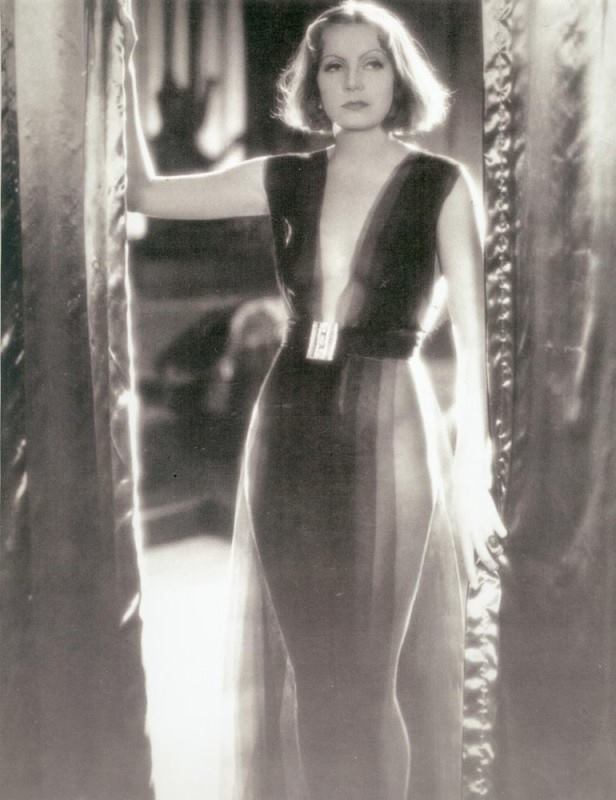
Gee whiz, why’d they cut that out?
- The real life Mata Hari has her life story covered over on Biography.com. After leaving the Indies, she became an exotic dancer in Paris, helping to popularize the striptease. She ended up sleeping with a number of rich and famous men from across the continent for money, until falling for an injured Russian captain. Hari’s attempts at becoming a spy failed in order to support him failed, and there’s some debate to whether or not she was a double agent.
- More screencaps, stills and posters over at DVD Beaver and Dr. Macro. For a huge selection of stills from the movie, definitely check out Garbo Forever’s page.
- If you like Lionel Barrymore, Karen Morley, and C. Henry Gordon, they also all star together in the quite different but also politically charged Washington Masquerade.
- Here’s the film’s trailer (though, considering the way it’s cut, I wouldn’t be surprised if this trailer was for a 40s reissue):
Awards, Accolades & Availability
- This film is available on Amazon and in The Greta Garbo Signature Collection.
Comment below or join our email subscription list on the sidebar! |
||
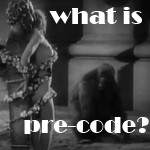 |
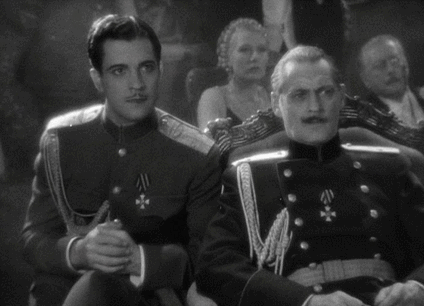 |
 |
 |
 |
|

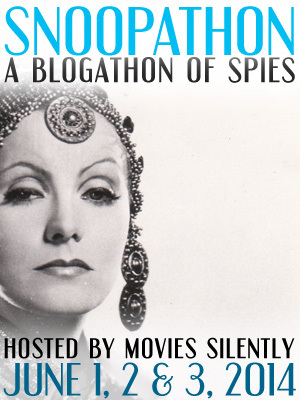
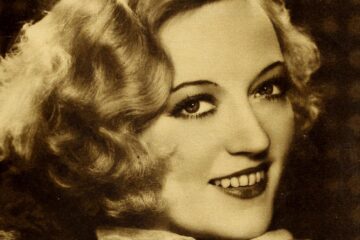
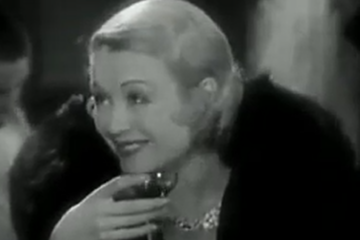
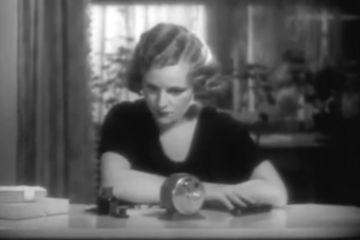
25 Comments
Clayton @ Phantom Empires · June 2, 2014 at 7:07 am
Nice write-up! I’ve never been a Garbo fan (she seems too much like a youthful, but bitter, over-sexed grandma), but this one took me by surpise. I’ve seen the cut version (I assume from your screenshots), and I enjoyed it. I’m a Navarro fan, which is whet led me to it. I think I’m inspired to see it again! Thanks!
Danny · June 3, 2014 at 1:30 pm
Sure thing. Thanks for coming by!
Movies, Silently · June 2, 2014 at 11:27 am
I think it was William K. Everson who wrote that neither Valentino nor Garbo had a great film between them. While this is an arguable point, I do agree that neither one was used as well they could have been in the majority of their vehicles.
Totally agree about Novarro. I adore the man but he was always at his best when he was allowed to be mischievous. And the accent mismatch…
Marvelous writeup of this intriguing and ultimately frustrating film.
Danny · June 3, 2014 at 1:56 pm
Well I’ve only seen one Valentino movie so I can’t comment on that, but I think Garbo had a couple of good pictures in her– Flesh and the Devil is pretty sumptuous, I’m a fan of Ninotchka, and Anna Christie has grown on me. But, yeah, I see where the problem comes in where so many of Garbo’s vehicles simply seem to bank on her appeal over anything else.
And Novarro’s performance/character kills the film for me. I think if Alexis had a playful side (like in The Cat and The Fiddle) the movie would be much better off.
Nakis · June 2, 2014 at 7:38 pm
Very interesting review. With regards to Garbo well to my mind she is the greatest although I have to admit it took me years to understandher genius and appeal. The point about Garbo is that she is apart from any other actor and actress one can possibly imagine, both physically, visually and emotionally. She is a poetic actress, hand has a unique power to suggest all sorts of emotions and sensations. She is not there to do accents and tricks. She is a true cinematic genius of an actress. Her whole being, her face, body language speak volumes and adapt perfectly to her environement and she is the only screen actress ever who can show connexion and give life to inanimate objects. Think of her memorising scene in Queen Christina or the flower hospital scene in the silent ”Woman of Affairs”. But having seen many times all her films both silent and talkies now I find her incomparable. In order to understand her appeal try and see as many of her films as vehicles, sometimes lesser known titles contain some of her very best performances. For example the silent ”Woman of Affairs’ is definitely one of of her most alluring and extraordinary films and performances. And there is also the wonderful, sensual, brilliantly visual silent ”The mysterious Lady”. And to prove her extraordinary diversity as an actress, contrary to popular belief, see her first in her majestic androgynous ”Queen Christina;; and then as an ”ordinay” yet complex woman in ”The painted veil”. To go back to ”Mata Hari”, the uncut verison of the film has survived but unfortunately nothing has been done up to this day to restore it and release it on DVD. In 2005 I attended a couple fo screenings of Garbo films at the Cinematheque in Brussels, among those, Mata Hari and to my astonioshment I watched the uncut print of this film which is quite extraordinary. I did try to contact Warner Brothers through the kind intervention of Mark Vieira but up to this day no news from them.
Danny · June 3, 2014 at 2:06 pm
I’m surprised that Warner Brothers is laid back on it to be honest– they’re one of the studios that does a great job doing restorations and getting classic movies out there. I imagine they either must be holding off, planning a nice blu-ray release for Mata with the additional footage, or that there’s some rights/prints difficulty, since nearly 10 years seems like a long wait for such a big find.
As for what you’re saying about Garbo, if this article sounded down on her, trust me, she’s grown on me quite a bit. It helped reading Mick LaSalle’s Complicated Women which dotes on her and helped me better understand what I didn’t get about her appeal. I’m going to hit all of her pre-Codes eventually (naturally), and I hope to gain a better appreciation after that.
Nakis · June 3, 2014 at 4:30 pm
It is quite disapponting that Warner Brothers have not done anything yet to restore the uncut verison of Mata Hari and re-release it. The original verison does give a more sensual and daring view and it is definitely worth a restoration. Actually reading the article was quite enjoyable and it did remind me that it took me some time to fully comprehend Garbo’s appeal. Even ”Camille” was not one of my favorites for quite some time, but greu up to love it after I have seen the other Garbo vehicles and having read Mick’s book or even older essays on her like Charles Affron ”The Divine Garbo”, gives an insightful look of what made Garbo so extraordinary.
BlondeAtTheFilm · June 3, 2014 at 11:32 pm
Great review! Your photo captions made me laugh out loud, with “He’s also apparently wearing stilts here” being my favorite! I definitely want to watch this movie again after reading your post. I miss the completely over-the-top and ridiculously awesome costumes and set design of early and classic Hollywood. Diegetic world be damned! Thanks for a great read!
Nakis · June 4, 2014 at 8:22 am
Thinking about this ilm in particular and its amazing visual context as well, due to William Daniels wonderful cinematography as well as Cedric Gibbon’s designs and naturally Adrian’s memorable costumes, one regrets that Hollywood has lost that element in most of todays films. It is hard to think of a modern day vehicle which strikes us in its visual context. Can you name a film which you will rememebr fondly for its costumes? Not just because thety are extravagant but because they are part of the story and character. At the beginning of Mata Hari the great Garbo appears as a more distanced cold goddess dressed in gold. As she falls in love her costumes become more simple leading to that extraordinay black outfit for the execution scene which adds a touch of spirituality to her character,
Danny · June 4, 2014 at 8:07 pm
I think you definitely hit some good points here, and, yeah, Hari’s appearance definitely becomes more stripped down as the movie progresses. Few movies made these days look as sumptuous as Mata Hari did.
Danny · June 4, 2014 at 7:54 pm
I miss the old costumes too– few movies seem to capture the same kind of over-the-top designs as well as brilliantly sexy lines that old costumers knew too well. Thanks for coming by!
Silver Screenings · June 4, 2014 at 1:17 am
I’ve not seen this film but, judging by your screencaps, it looks gorgeous. (Including Garbo’s “sparkly outfits”, as you pointed out.)
I’m not sure how big of a Garbo fan I am, to be honest, but I think this film is definitely worth a look.
Danny · June 4, 2014 at 7:58 pm
I think watching a couple of Garbo movies is essential, even if it turns out not to be your speed. She’s alluring even if her films are inconsistent. Give this, Anna Christie and Ninotchka a shot. Hopefully you find a new favorite!
Silver Screenings · June 4, 2014 at 11:51 pm
Oh yes, I’m a big fan of Garbo in Ninotchka, but not so much Grand Hotel. But I will give Anna Christie a try and see how it goes. Thanks!
Joe Thompson · June 4, 2014 at 9:12 am
I enjoyed your review. I generally like Garbo better in silent movies than in talkies, except for Ninotchka. Now I want to see a restored version. Thank you for sharing.
Danny · June 4, 2014 at 7:33 pm
I’m with you on that. Thanks for dropping by!
Nakis · June 4, 2014 at 8:21 pm
Costumes tell stories and lots of things about the character. Adrian understood this well and adapted his ideas brilliantly to Garbo’s unique physique and movement. Today’s Hollywood could take a couple of lessons by watching and getting inspiration from these old classic films.
kristina · June 5, 2014 at 8:22 am
great read, that LaSalle book did wonders for me too, to help me discover more pre-codes and their appeal but also to “get” people like Garbo and Shearer, etc. You are so right about Adrian and the MGM spectacle being just as much the stars too. btw I don’t often (enough) swing by to comment from my reader, but good time to say I enjoy your blog a lot.
Danny · June 7, 2014 at 3:39 pm
Thanks Kristina, I appreciate the kind words (and I’m sure Adrian would appreciate them too!).
Todd Benefiel · June 6, 2014 at 5:28 am
The only Garbo film I’ve seen is ‘Ninotchka’, which I liked, so it was fun to read about another, and one that I’ve always wanted to see. And I love that photo in the Gallery with Garbo and Barrymore enjoying what appears to be a 1930s version of the teacup ride at Disneyland! Thanks for the neat review, Danny!
Danny · June 7, 2014 at 4:19 pm
Yeah, luckily Paris of the first World War had never heard of It’s A Small World or else there never would have been an armistice. And thanks for coming by!
girlsdofilm · June 6, 2014 at 8:22 am
Wonderful post. I knew so much about the myth of Garbo, and I was disappointed to find my first screen introduction to her (Ninotchka) didn’t live up to the hype. After a few re-watches I felt I was closer to understanding her. I’ve never actually seen this film, but I agree with the comments about Adrian and spectacle – by making the stars so otherwordly and untouchable it makes them harder for contemporary audiences to relate to, but I guess at the time that was all part of the escapism attraction.
Danny · June 7, 2014 at 4:23 pm
I guess I’ve never seen that disconnect very clearly before, but the way you laid it out there is great. Thank you!
Lê · June 16, 2014 at 11:38 am
I can’t deny that I watch Garbo’s films for Garbo only. Her presence is magnetic, and I had to waut a long time until I realized who her co-stars were, since I was paying attention only to her. I liked Mata Hari, especially the candle scene, and Garbo’s beauty is incredibly well-used here.
Don’t forget to read my contribution to the blogathon! 🙂
Greetings!
Le
http://www.criticaretro.blogspot.com.br/2014/06/interludio-notorious-1946.html
Danny · June 24, 2014 at 9:53 pm
I enjoyed your review quite a bit, Le, and thank you for coming by!
Comments are closed.